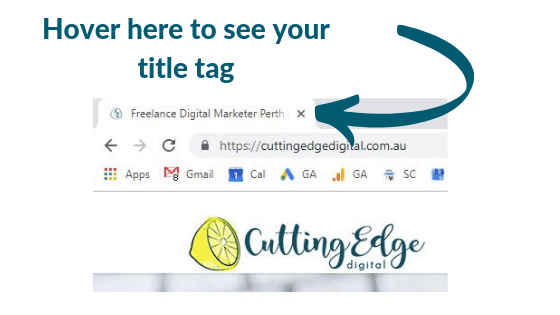When it comes to on page SEO elements, one of the most important ones is your title tags. They need to be descriptive, relevant to the page and make the reader want to click through to your website.
But how do you write great title tags for your website?
I’ll take you through everything you need to know about title tags for your website to help your SEO skyrocket your pages to that all-important first page of the Google results.
What Are Title Tags?
Title tags are usually the first thing someone read about your website.
When you search on Google and the results page pops up, the heading in blue above each website URL is the title tag.
If you’ve optimised your website, it might look something like mine:

Some title tags show just the name of the page, like ‘Home’ or ‘About’ instead of a longer phrase describing the page. This usually happens when you haven’t yet optimised your page so it just pulls through the name or heading of the page as the title tag.
However, before you even start writing your title tags, you need to do your keyword research. Through this process, you’ll establish which keyword you want to target on each page of your website and use in your title tags.
How Can I See My Title Tags?
If you hover over any browser tab, you’ll usually see some words pop up and then disappear.
That’s your title tag!
Give it a try now -open your website and hover over the browser tab – what do you see?
Here’s where to look if you aren’t sure:

What’s The Purpose Of A Title Tag?
As I already mentioned, a title tag is a crucial element of your on-page SEO.
On-page SEO, if you’re wondering what that is, is any SEO carried out on your website (changing your content, making it load faster, writing great meta descriptions etc.).
It’s one of the key elements Google (and other search engines) look at to determine what your page is about and whether it makes a great result to return for a search.
Along with the meta description, it’s one of the first things you should look at when starting to optimise your website.
How Long Should Title Tags Be?
Currently, title tags should be no longer than 50-60 characters.
Why the range?
That’s because title tags are actually measured in pixels, not characters. And in pixels, that’s 600 pixels. Because characters vary in size, it’s best to stick around the 50 character mark.
If you want to know how much space you have, this is a super handy tool to check your pixel length as you type.
If your title tag is too long, it will be truncated on your search result and end mid-sentence with … not the best look!
Should Title Tags Be Unique?
YES!
Definitely!
Always write a unique title tag for each page. If you write the same title tag for every page on your website, it’s confusing to Google to know which page is actually the best result to return.
Say for example, you have a home building business, and have separate pages for new builds, renovations, and extensions. If you have the same title tag on each page (‘New Home Builders Brisbane’), when someone searches for ‘new home builders Brisbane’ Google will see several pages on your website all claiming to be about that particular search term.
So you could end up sending people to your renovations page, when you really want them to land on your new build page.
I use the tool Screaming Frog (yep, that’s its actual name!) to crawl websites before I start working on them.
This tool will give you a complete list of URLs on your website and from here, you can make a shortlist of the pages you need to optimise. It does include back end and image URLs so you can strip these out manually and just work on your key static pages to start with.
What Should It Include?
OK so now you know what title tags are, how long they should be and why they’re important, but what should you include in them?
This is where it gets a bit more subjective but there are several things most SEO’s will agree on.
Firstly, it should include the search term you’ve chosen for that page (when you did your keyword research).
Secondly, it should include your brand name. When people are browsing search results, they want to know who they’re clicking through to, before they click. The more information you can give users before they click, the less chance you have of them clicking away from your website if their expectations aren’t met (this results in a high bounce rate, which you want to avoid).
Even if people don’t click when they see your name, if you keep consistently appearing for searches they do, chances are they may well end up clicking through later on.
Also be aware that if Google doesn’t think your title tag is good enough or relevant enough, they can replace it in the search results with something else. It could be a phrase from your page or even your homepage, sometimes it could even be a snippet about your business from another website!
So writing a title tag that’s relevant for your page is super important.
How To Format Your Title Tag
Use good formatting. If you’re adding more than one keyword phrase to your title tag, use a symbol to break them up. It makes it easy on the eye for your reader and it looks good as well.
Many sites recommend formatting as follows:
Primary Keyword – Secondary Keyword | Brand Name
If you don’t have a secondary keyword or phrase, don’t stress, just add your primary one and your brand name.
Formatting isn’t just important for Google, it’s important for your social media channels as well. Your title tag will appear on links shared on social so it needs to be well-formatted otherwise it might look weird on Facebook, LinkedIn and other channels.
How To Add A Title Tag To Your Website
Every platform should have a way to add a title tag to a page.
On WordPress, I use the Yoast plugin which allows you to add title tags, meta descriptions, and a focus keyword.
Whatever platform you’re on, if you can’t find the title tag field, just Google it and I’m sure you’ll find the relevant guide to help you find it.
One Last Tip
My final tip for how to write great title tags for your website: always write for your audience.
Don’t focus only on writing for Google. It’s easy to get caught up thinking about getting to rank on search engines and forgetting that really your primary goal should be getting clicks to your website.
And writing a great title tag and meta description will help you get those clicks.
Still not sure where to start or just can’t get your head around trying to DIY your SEO?
Get in touch with me today for a free chat and an obligation-free quote for SEO set up and content marketing for your website.
I love helping businesses optimise their online presence and help you get business from your website.
Contact me online now – my availability is limited as a solo freelance digital marketer. That means you won’t be fobbed off to an account manager or speak to someone who doesn’t actually do the work!



Comments are closed.